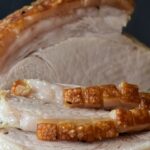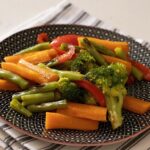
Oster Lammbraten is a classic German Easter main dish, symbolizing rebirth and spring. Traditionally served on Easter Sunday, this herb-marinated roast lamb is slow-cooked to perfection, resulting in tender, flavorful meat.
Served with potato dumplings, red cabbage, or spring vegetables, this dish is the highlight of many Easter meals across Germany. The lamb is often marinated in a blend of garlic, rosemary, thyme, and olive oil, then roasted until golden brown and juicy.
In this guide, we’ll share the history of Oster Lammbraten, its role in German Easter traditions, and provide a detailed, easy-to-follow recipe for making it at home.
History & Cultural Significance
The Origins of Oster Lammbraten
Roast lamb has been a symbol of Easter for centuries, dating back to Jewish Passover traditions and later adopted into Christian celebrations. In Germany, lamb is especially meaningful during Easter, representing purity, sacrifice, and renewal.
Oster Lammbraten is typically prepared for Easter lunch or dinner and is considered a festive centerpiece. In rural regions, families often use locally sourced lamb, marinated with fresh herbs and garlic, and slow-roasted until tender.
This dish is often served alongside potatoes, braised red cabbage, or white asparagus, showcasing the flavors of spring.
For more Easter main dishes, explore recipes like Hase in Rotweinsauce or Osterbraten.
Ingredients & Preparation
Ingredients
- 1.5–2 kg (3–4.5 lbs) leg of lamb (bone-in or boneless)
- 4 cloves garlic, minced
- 2 tbsp fresh rosemary, chopped
- 2 tbsp fresh thyme, chopped
- 1 tbsp Dijon mustard (optional)
- 2 tbsp olive oil
- Salt and black pepper, to taste
- 150ml (⅔ cup) dry white wine or lamb stock
Optional additions:
- 1 onion, quartered
- 2 carrots, roughly chopped
- 1 celery stalk
How to Make Oster Lammbraten
Step 1: Marinate the Lamb
- In a small bowl, mix garlic, rosemary, thyme, mustard, olive oil, salt, and pepper.
- Rub the mixture all over the lamb.
- Cover and refrigerate for at least 2 hours (preferably overnight).
Step 2: Prepare for Roasting
- Preheat oven to 180°C (350°F).
- Place lamb in a roasting pan. Surround with onions, carrots, and celery, if using.
- Pour wine or stock into the pan.
Step 3: Roast
- Roast for 1.5–2 hours, depending on doneness (use a meat thermometer: 60°C/140°F for medium).
- Baste occasionally with pan juices.
Step 4: Rest and Serve
- Let lamb rest for 10–15 minutes before slicing.
- Serve with pan gravy and traditional Easter sides.
Serving Suggestions & Variations
How to Serve
Oster Lammbraten pairs beautifully with:
- Kartoffelsalat (potato salad) or Kartoffelknödel (dumplings)
- Frühlingsgemüse (spring vegetables)
- Rotkohl (braised red cabbage)
- A glass of dry red or white wine
Variations
In Bavaria, the lamb is sometimes glazed with honey and mustard. In Swabia, it’s served with herb butter and asparagus.
For another festive option, try Lachs mit Senfsauce.
Oster Lammbraten is a tender, aromatic Easter roast, deeply rooted in German culinary and religious traditions. Its combination of herbs, garlic, and slow roasting makes it a true celebration dish.
Serve it with traditional German sides to create a memorable Easter meal your guests will love.
Looking for more Easter recipes? Explore Hase in Rotweinsauce, Eierlikörtorte, and Spargelsalat.







